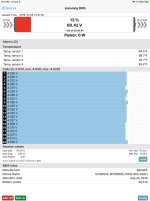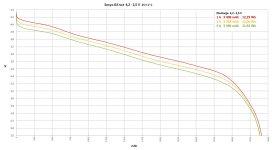You are using an out of date browser. It may not display this or other websites correctly.
You should upgrade or use an alternative browser.
You should upgrade or use an alternative browser.
Any need to Balance?
- Thread starter BlueSeas
- Start date
BlueSeas
100 W
The peak discharge is designed at 10A per cell, or 40A for the pack. Max charge rate is 1A per cell or 4A. This a charger limitation.
I stopped this charge at 4.05V, or roughly 80% charge. The BMS balance is adjustable, using default values of 4.0V to start balancing and .03V difference to trigger shunting of high cells. In this charge, it never saw >.03V difference, and charge terminated without balancing.
I will probably do a "full" charge to 4.2V when installed, but the bike needs to be a bit further along so I can discharge. Don't want to store a pack at 100% charge.
The cells came at 3.508 to 3.529V. I sorted them and built the 4P cells mixing the low and high cells to start as even as possible.
I stopped this charge at 4.05V, or roughly 80% charge. The BMS balance is adjustable, using default values of 4.0V to start balancing and .03V difference to trigger shunting of high cells. In this charge, it never saw >.03V difference, and charge terminated without balancing.
I will probably do a "full" charge to 4.2V when installed, but the bike needs to be a bit further along so I can discharge. Don't want to store a pack at 100% charge.
The cells came at 3.508 to 3.529V. I sorted them and built the 4P cells mixing the low and high cells to start as even as possible.
With an accurate capacity tester, you'll find a 4.05V absorb setpoint can get you much higher than 80% SoC.
In effect can be Full if you can terminate based on tapering amps, at say 0.02C.
For the commissioning initial balance I'd use .01V as delta trigger. Absorb at 4.05V to start, check, then go up in 0.05 increments and watch for differences.
If balancing regularly, go a step higher voltage than you hit during normal usage charge cycles.
In effect can be Full if you can terminate based on tapering amps, at say 0.02C.
What charger? Storage discharging is a good capability to have and use regularly. Capacity testing even more so, and having the latter gives you the former.BlueSeas said:I will probably do a "full" charge to 4.2V when installed, but the bike needs to be a bit further along so I can discharge.
For the commissioning initial balance I'd use .01V as delta trigger. Absorb at 4.05V to start, check, then go up in 0.05 increments and watch for differences.
If balancing regularly, go a step higher voltage than you hit during normal usage charge cycles.
BlueSeas
100 W
Right now I'm charging with a 0-120V lab power supply. Regular charges will be using a Grin Cycle Satiator.
Not sure what you are suggesting for a capacity tester? Will have data from initial discharges via a Cycle Analyst. That should provide a pretty accurate read on the capacity.
I haven't delved into all the programming options on the Satiator. Panasonic says CC/CV starting at 1.675A per cell, ending at 4.2V tapering to .067A. Isn't the consensus on this forum that cycle life is extended using the 20-80% SOC middle ground? So what is charge termination at 80% in Voltage and Current?
Discharge for 20% is 3.3V at 4A, a reasonable average current level. So about 66V for the pack.
I'm not sure what's wrong with the selection of Panasonic cells:
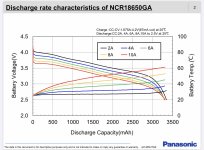
They are tested at up to 10A in the specifications. And 10A is really a "peak" in this design. The controller will be programmed for 40A maximum, and the pack build includes a 40A DC circuit breaker. The simulator indicates 30A at top speed on level ground (Florida). And a mere 6A at a 20mph bike path speed limit.
There isn't a fixed "mission", ie a daily commute or regular route. Nor will the bike get used every day. The Panasonic/Sanyo cells show a 30% loss of capacity after 500 cycles. That's a lot compared to the LiFePO4 cells I'm used to working with in traction battery applications. But 72V of LiFePO4 wouldn't fit in the battery bag. At 100 days use per year, I'm hoping this pack lasts until the next great leap in chemistry. Haha...been waiting on that for more than 5 years now, at least for stuff available to the public. They have increased rates, but not density/capacity much.
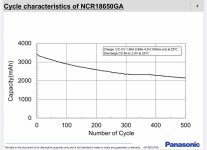
Is there any good data that supports the 20-80% SOC usage window? By that, a comparison of capacity at 1) 500 full cycles, that's 432,000 watt hours for this pack to 2) 834 cycles using 60% of of capacity still equaling 432,000 watt hours. We know (if you believe Panasonic), the cell capacity for 500 full cycles is reduced by 30%. You probably need a substantial improvement to sacrifice the flexibility of a 40 mile range vs. 24 miles imposed for "battery preservation" when new. That's 28 vs 17 mile range after the standard 30% capacity loss.
The more I ponder the numbers...I think you might as well use full capacity? Set the 3.3V per cell as the "reserve" point...sort of like the old 3 position fuel valve on a motorcycle. Know you better be within 5-7 miles (20ish % of total range) of a plug by that point.
(Edit added cycle graph)
Not sure what you are suggesting for a capacity tester? Will have data from initial discharges via a Cycle Analyst. That should provide a pretty accurate read on the capacity.
I haven't delved into all the programming options on the Satiator. Panasonic says CC/CV starting at 1.675A per cell, ending at 4.2V tapering to .067A. Isn't the consensus on this forum that cycle life is extended using the 20-80% SOC middle ground? So what is charge termination at 80% in Voltage and Current?
Discharge for 20% is 3.3V at 4A, a reasonable average current level. So about 66V for the pack.
I'm not sure what's wrong with the selection of Panasonic cells:

They are tested at up to 10A in the specifications. And 10A is really a "peak" in this design. The controller will be programmed for 40A maximum, and the pack build includes a 40A DC circuit breaker. The simulator indicates 30A at top speed on level ground (Florida). And a mere 6A at a 20mph bike path speed limit.
There isn't a fixed "mission", ie a daily commute or regular route. Nor will the bike get used every day. The Panasonic/Sanyo cells show a 30% loss of capacity after 500 cycles. That's a lot compared to the LiFePO4 cells I'm used to working with in traction battery applications. But 72V of LiFePO4 wouldn't fit in the battery bag. At 100 days use per year, I'm hoping this pack lasts until the next great leap in chemistry. Haha...been waiting on that for more than 5 years now, at least for stuff available to the public. They have increased rates, but not density/capacity much.

Is there any good data that supports the 20-80% SOC usage window? By that, a comparison of capacity at 1) 500 full cycles, that's 432,000 watt hours for this pack to 2) 834 cycles using 60% of of capacity still equaling 432,000 watt hours. We know (if you believe Panasonic), the cell capacity for 500 full cycles is reduced by 30%. You probably need a substantial improvement to sacrifice the flexibility of a 40 mile range vs. 24 miles imposed for "battery preservation" when new. That's 28 vs 17 mile range after the standard 30% capacity loss.
The more I ponder the numbers...I think you might as well use full capacity? Set the 3.3V per cell as the "reserve" point...sort of like the old 3 position fuel valve on a motorcycle. Know you better be within 5-7 miles (20ish % of total range) of a plug by that point.
(Edit added cycle graph)
I have also Sanyo GA cells in my 10s5p pack.
Your information are probably mainly from Panasonic/Sanyo datasheets.
Assumptions for decent GA lifetime (up to 1000 cycles/80 % capacity) : charge 1A max, discharge continuous 2,5 - 3A max, peak short time discharge cca 4 - 5 A max, 50 – 60 % DOD max.
Charging only before ride if possible, don´t let lay pack charged. Store at cold place (Florida).
I enclose pictures where you can see where voltage get settled at 2A discharge pulses.
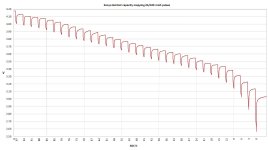
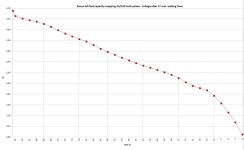
Your information are probably mainly from Panasonic/Sanyo datasheets.
Assumptions for decent GA lifetime (up to 1000 cycles/80 % capacity) : charge 1A max, discharge continuous 2,5 - 3A max, peak short time discharge cca 4 - 5 A max, 50 – 60 % DOD max.
Charging only before ride if possible, don´t let lay pack charged. Store at cold place (Florida).
I enclose pictures where you can see where voltage get settled at 2A discharge pulses.


John in CR
100 TW
In the future, prior to pack assembly put all cells in parallel for a day or 2 to get the cells in perfect balance to start.
John in CR said:In the future, prior to pack assembly put all cells in parallel for a day or 2 to get the cells in perfect balance to start.
Yes, very good remark. Levelling the cells should be No 1 step.
BlueSeas
100 W
Doc,
I see that at about 3.4V there is a noticeable fall off on discharge. Do you have a measure of capacity or total elapsed time for each graph? I'm hoping to see about 3000 mAh.
But it's true....so far all my data is from the spec sheet.
Bob
I see that at about 3.4V there is a noticeable fall off on discharge. Do you have a measure of capacity or total elapsed time for each graph? I'm hoping to see about 3000 mAh.
But it's true....so far all my data is from the spec sheet.
Bob
BlueSeas
100 W
John in CR said:In the future, prior to pack assembly put all cells in parallel for a day or 2 to get the cells in perfect balance to start.
I always used to do that for traction LFP banks. Parallel and charge to 3.6V, then assemble bank. With LFP, you must charge. 3.3V at rest is anywhere between 45 to 80% SOC. These cells seem to have a better defined relationship of voltage to SOC.
But for this build...how do you parallel 80 slightly larger than AA cells easily? I was stumped. Still am. That said, I randomly took 4 cells of the 100 I purchased, placed them in an Opus charger (supposed to be 4 independent channels?) and found they took pretty much the same numbers to go from 30% to 100%. So I just built the pack. I will post the first full charge graph in a couple days, but don't expect to have a significant balance issue.
The Chinese vendor selling the cells sent fresh off the assembly line cells, that were discharged to a very similar level. Probably automated. It's the only reason I appear to have been able to skip the parallel step.
BlueSeas
100 W
john61ct said:oops
When you see V drop accelerate below 3.5Vpc, best for longevity to stop discharging.
Fine for capacity testing, talking normal usage cycling
I understand...but...where is the longevity data? What is the quantified benefit. I never believed the data for Winston/Thundersky/Calb/Sinopoly/GBS/Forztec. It was all marketing. For some reason I believe Sanyo/Panasonic and the Koreans more. But even they don't publish what short cycles do to capacity retention.
LFP shows 2000 cycles in testing (several makers). However, put them in a 120 degree F engine room with 24 hours or more duty cycles, allowing them time to get fully heat soaked, and you will lose 10% per year due to heat (and time). I've measured this over 3 consecutive years. Even if you don't charge them underway. There is a time factor as well. I've seen 50% charged cells new in the box lose 5% in a year waiting for installation.
This on $7000-25000 cell groupings. I suppose it's all relative, but how much do you want to baby a $350 dollar set of cells?
Not sure what you're trying to say there, You asked, I answered, just trying to be helpful.
Yes, high heat hurts longevity, you'd have to be stupid to put a bank worth thousands in a poorly ventilated engine room IMO.
The LFP vendors grossly **underestimate** cycle longevity, that is EV high C-rate data.
In gentle House bank usage, properly cared for I reckon 10,000 cycles will prove mainstream IRL. Seen many banks with under 1% capacity loss at 2-3000 daily use cycles, some purposefully brought down to 80% DoD every cycle, even when not necessary.
Shallower cycling means triple the lifespan or more.
Sure if maximizing longevity is not a goal, for whatever reason, fine, settle for just 2-3000 cycles.
But then why waste our time asking the OP question, from that POV they're fine!
> Winston/Thundersky/Calb/Sinopoly/GBS/Forztec
One of those is not like the others
Curious about Forztec, know any trusted suppliers in the NA market? Prefer not to import from overseas. . .
Yes, high heat hurts longevity, you'd have to be stupid to put a bank worth thousands in a poorly ventilated engine room IMO.
The LFP vendors grossly **underestimate** cycle longevity, that is EV high C-rate data.
In gentle House bank usage, properly cared for I reckon 10,000 cycles will prove mainstream IRL. Seen many banks with under 1% capacity loss at 2-3000 daily use cycles, some purposefully brought down to 80% DoD every cycle, even when not necessary.
Shallower cycling means triple the lifespan or more.
Sure if maximizing longevity is not a goal, for whatever reason, fine, settle for just 2-3000 cycles.
But then why waste our time asking the OP question, from that POV they're fine!
> Winston/Thundersky/Calb/Sinopoly/GBS/Forztec
One of those is not like the others
Curious about Forztec, know any trusted suppliers in the NA market? Prefer not to import from overseas. . .
John in CR
100 TW
BlueSeas said:John in CR said:In the future, prior to pack assembly put all cells in parallel for a day or 2 to get the cells in perfect balance to start.
I always used to do that for traction LFP banks. Parallel and charge to 3.6V, then assemble bank. With LFP, you must charge. 3.3V at rest is anywhere between 45 to 80% SOC. These cells seem to have a better defined relationship of voltage to SOC.
But for this build...how do you parallel 80 slightly larger than AA cells easily? I was stumped. Still am. That said, I randomly took 4 cells of the 100 I purchased, placed them in an Opus charger (supposed to be 4 independent channels?) and found they took pretty much the same numbers to go from 30% to 100%. So I just built the pack. I will post the first full charge graph in a couple days, but don't expect to have a significant balance issue.
The Chinese vendor selling the cells sent fresh off the assembly line cells, that were discharged to a very similar level. Probably automated. It's the only reason I appear to have been able to skip the parallel step.
LiFePo4 cells are quite different with cell voltage not being a reliable measure of SOC, you have to fill them all the way up to balance, though some argue that bottom balancing is ok too. Since I only top balance once the pack is built, I stick with that. For LFP packs I always buy extra cells and run a discharge test to match them based on capacity and IR in order to minimize the need to balance charge since still don't use Battery Murdering Systems. As a human BMS, I've yet to kill a cell or a pack, but I use conservative charge voltages and DOD's.
For ease in balancing non-LFP cells, after checking all cells for balance from the factory to weed out duds, I build all of my parallel structure first leaving something to easily connect to for balancing. I charge them to full and leave connected in parallel for 2 or 3 days if using alligator jumper wires. Once all read exactly in balance, I jumper them in series and discharge to below 4V/cell using 100W light bulbs. Then I recheck for balance to ensure that assembling the blocks of cells didn't damage any cells and/or check for weak cells.
With the battery being the heart and most expensive part of the system, I invest significant time in pack building. The extra effort pays dividends in longevity.
BlueSeas
100 W
John61,
Sorry...not really trying to shoot the messenger.
I learned the hard way about heat...that first install was my trawler in 2012. They were in use 6 years, 2 with the subsequent owner. No place for a big house bank except in the ER. These were GBS cells, they are a slight chemistry variation. So are/or were Thundersky with the Yttrium. Of the bunch, Calb was my favorite. There is or was a Calb USA a couple years ago and several resellers. The Forzatecs were purchased by the owner...164 100Ah cells worth of them. He bought direct from the factory and had them ocean freighted to the US and then trucked across the country. Never heard of them for sale in the US.
Sorry...not really trying to shoot the messenger.
I learned the hard way about heat...that first install was my trawler in 2012. They were in use 6 years, 2 with the subsequent owner. No place for a big house bank except in the ER. These were GBS cells, they are a slight chemistry variation. So are/or were Thundersky with the Yttrium. Of the bunch, Calb was my favorite. There is or was a Calb USA a couple years ago and several resellers. The Forzatecs were purchased by the owner...164 100Ah cells worth of them. He bought direct from the factory and had them ocean freighted to the US and then trucked across the country. Never heard of them for sale in the US.
BlueSeas
100 W
Doc,
Thanks for the graph. That's puts the other charts in a better perspective. We will see how it works out.
Thanks for the graph. That's puts the other charts in a better perspective. We will see how it works out.
BlueSeas
100 W
John in CR...
I agree that a human BMS is possible for LFP in 12/24 V traction use. But it needs to be a techie type user. I've only really had one customer I'd trust.
The bottom balance was championed by EVTV's host personality and EV builder Jack. For a short range EV home garage conversion of an old ICE car, I think he's right on the money. That way when you invariably try to stretch the range, all the cells run out at the same time and you save the bank from self destruction.
Thanks for the steps to weed out bad cells. Guess I'm still hoping I don't have any. Will know soon enough.
I agree that a human BMS is possible for LFP in 12/24 V traction use. But it needs to be a techie type user. I've only really had one customer I'd trust.
The bottom balance was championed by EVTV's host personality and EV builder Jack. For a short range EV home garage conversion of an old ICE car, I think he's right on the money. That way when you invariably try to stretch the range, all the cells run out at the same time and you save the bank from self destruction.
Thanks for the steps to weed out bad cells. Guess I'm still hoping I don't have any. Will know soon enough.
Similar threads
- Replies
- 3
- Views
- 708
- Replies
- 19
- Views
- 977
- Replies
- 3
- Views
- 409
- Replies
- 3
- Views
- 804


